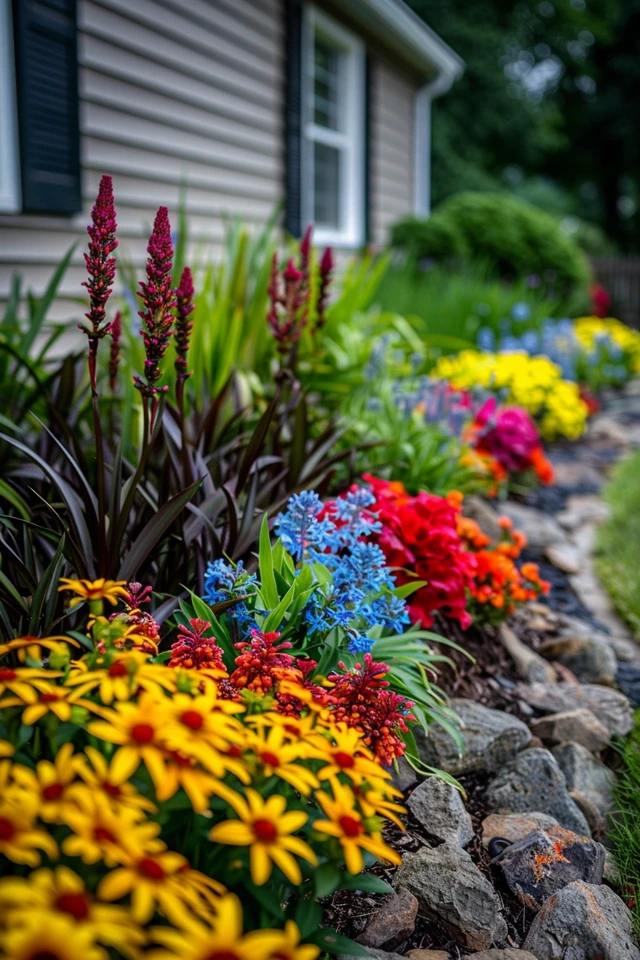Landscaping in shaded areas can be challenging, as grass often struggles to grow in these conditions. However, with the right landscaping ideas, you can create a beautiful and low-maintenance yard that thrives in the shade. By incorporating a variety of shade-loving plants and ground cover alternatives, you can transform your space into a lush oasis. Below, we explore different landscaping ideas where grass won’t grow, including lawn alternatives, drought-tolerant landscaping options, and low-maintenance yard ideas.
Key Takeaways:
- Landscaping in shaded areas can be challenging, but there are plenty of grass-free landscaping ideas available.
- Consider lawn alternatives, such as ground cover alternatives, to create a unique and attractive yard.
- Drought-tolerant landscaping can help conserve water while still maintaining a beautiful outdoor space.
- Low-maintenance yard ideas are essential for busy homeowners who want to enjoy their yard without constant upkeep.
- Embrace the beauty and tranquility of shade gardening by designing a well-thought-out shade garden.

Choosing Shade Plants for Your Yard
When landscaping in shady areas, it’s important to choose plants that thrive in low-light conditions. Shade plants, such as shade perennials, shade groundcovers, and shade shrubs, are ideal for adding color and texture to your yard.
Some popular shade plants include Columbine, Ferns, Bleeding heart, Hostas, and Clematis. These plants not only tolerate shade but also bring beauty and variety to your garden. They can be planted in flower beds or containers to create stunning displays.
For groundcovers, consider options like Bunchberry, Wild ginger, Astilbe, and Plumbago. These plants provide coverage in shady areas and add visual interest with their foliage and flowers.
Incorporating shade annuals can also enhance the beauty of your yard. Popular choices include Begonias, Periwinkle, Dahlia, and Impatiens. These annuals bring vibrant colors and can be easily changed each year to suit your preference.
When selecting shade plants, it’s crucial to consider their unique characteristics. Pay attention to their water and sunlight requirements, as well as their mature size. This will ensure that the plants thrive in your particular shade garden and are properly suited for your yard’s conditions.
Creating a lush and thriving shade garden is possible with the right selection of shade plants. Take the time to choose plant varieties that complement each other and consider their maintenance needs. With the right combination of shade perennials, groundcovers, and annuals, you can transform your shady yard into an enchanting oasis.

Designing a Shade Garden
Designing a shade garden requires thoughtful planning and consideration of the existing shade conditions in your yard. Before delving into the design process, take the time to assess the amount of shade your yard receives at different times of the day and throughout the year. This crucial step will help you determine the best plants and layout to create a thriving shade garden that complements your space.
One approach to add depth and visual interest to your shade garden is by incorporating plants of varying heights and textures such as trees, shrubs, and perennials. This layering effect creates a captivating landscape that showcases the unique beauty of each plant while maximizing the available shade. Consider using tall, shade-tolerant trees as a canopy, medium-height shrubs for a mid-level layer, and low-growing perennials for the ground cover.
Aside from plants, adding focal points within your shade garden can enhance the overall design and create a sense of serenity. Incorporate elements like a cozy bench nestled under a tree, a fire pit for cool evenings, or a piece of art that showcases your personal style. These focal points not only provide a place for relaxation and contemplation but also serve as eye-catching centerpieces that draw attention in your shade garden.
Moreover, creating pathways throughout your shade garden can guide visitors through the space and highlight different areas of interest. Whether you choose natural stone, stepping stones, or gravel, a well-designed path can enhance the overall aesthetic while providing practicality for navigating the garden. Consider curving the paths to add a sense of intrigue and discovery as guests explore your shade garden.
When designing your shade garden, remember to strike a balance between visual appeal and functionality. Ensure that the paths are wide enough for comfortable walking and that the focal points are strategically placed to be enjoyed from various angles. Additionally, embrace the opportunity to incorporate plants that thrive under the shade of trees, transforming those hard-to-landscape areas under the canopy into beautiful and cohesive parts of your shade garden.
In conclusion, creating a shade garden is an opportunity to showcase your creativity and design skills while embracing the unique challenges and beauty of a shaded yard. By carefully considering the shade conditions, incorporating plants of different heights and textures, adding focal points, and designing well-thought-out pathways, you can transform your shade garden into an inviting and enchanting outdoor retreat.

Conclusion
Landscaping in areas where grass won’t grow doesn’t have to be a challenge. By implementing these landscaping ideas, you can create a lush, low-maintenance yard that thrives in the shade. From choosing the right shade plants to designing a well-thought-out shade garden, you can transform your space into a serene oasis that will be the envy of your neighborhood.
Embrace the beauty of shade gardening and enjoy the tranquility it brings to your outdoor space. With the right selection of shade plants, such as shade perennials, groundcovers, and shrubs, you can add vibrant colors and textures to your yard even in low-light conditions. Consider incorporating different levels of height and texture in your shade garden design, using trees, shrubs, and perennials of varying heights to create depth and visual interest.
Don’t forget to consider focal points like benches, fire pits, or art pieces to bring a sense of serenity to your shade garden. Pathways can guide visitors through the space and highlight different areas of the garden. By carefully designing your shade garden, you can create a beautiful and inviting outdoor oasis that will provide a peaceful escape from the hustle and bustle of everyday life.

